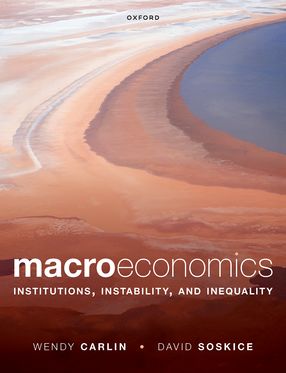Macroeconomics Institutions, Instability, and Inequality

Macroeconomics Institutions, Instability, and Inequality
|
ISBN: |
9780198838661 |
|
Binding: |
Paperback |
|
Published: |
24 Apr 2024 |
|
Availability: |
30
|
|
Series: |
$128.95 AUD
$146.99 NZD
Add To Cart Request an inspection copyDescription
At the cutting edge of the subject area, the authors bring the macroeconomics that researchers and policymakers use today into focus. By developing a coherent set of tractable models, the book enables students to explore and make sense of the pressing questions facing global economies.
Carlin and Soskice connect students with contemporary research and policy in macroeconomics. The authors' 3-equation model - extended to include the financial system and with an integrated treatment of inequality - equips students with a method they can apply to the enduring challenges stirred by the financial crisis and the Great Recession.
Key features
- Engaged with the latest developments in macroeconomic research, policy, and debate, the authors make the cutting edge accessible to undergraduate readers
- The theme of inequality is integrated throughout in modelling and applications, with incomplete contracts in labour and credit markets underpinning the presence of involuntary unemployment and credit constraints
- The content distils business cycles into a 3-equation model of the demand side, the supply side, and the policy maker, providing a realistic and transparent model which students can deploy to address the questions that interest them
- Open economy modelling for both flexible and fixed exchange rate regimes builds on the same foundations and handles oil and climate shocks, as well as the Eurozone crisis
- Features thorough treatment of the financial system and how to integrate the financial and business cycles, including coverage on policy design and implementation for financial stability in the wake of the 2008-9 financial crisis and an exploration of hysteresis in the context of the Great Recession
- Comprehensive coverage of monetary policy including the ample reserves regime and of fiscal policy and debt dynamics
- Unified treatment of exogenous and endogenous growth models emphasizing the different mechanisms through which diminishing returns to capital can be offset, while Chapter 17 on the ICT revolution examines the implications of innovation and technological change on the future of work and inequality
- Contains a chapter considering contemporary quantitative macroeconomics research - including the Heterogeneous Agent New Keynesian (HANK) model - exposing students to the tools that researchers currently use, as well as the benefits and limitations of these methods
- End-of-chapter 'Checklist questions' enable students to assess their comprehension, while 'Problems' prompt students to apply independent critical thought
- Also available as an e-book enhanced with access to The Macroeconomic Simulator, Animated Analytical Diagrams, and self-assessment activities enabling students to recap content and investigate how models work at their own pace
Digital formats and resources
This title is available for students and institutions to purchase in a variety of formats and is supported by online resources. The e-book offers a mobile experience and convenient access along with self-assessment activities, multi-media content, and links that offer extra learning support: Find the eBook on VitalSource.
This title is supported by a range of online resource for students including multiple-choice-questions with instant feedback, interactive Animated Analytical Diagrams, access to The Macroeconomic Simulator, web appendices which develop chapters 1, 4, 7, and 18.
In addition, lecturers can access PowerPoint slides to accompany each chapter and answers to the problems and questions set in the book.
Contents
Introduction
Part 1: Basics: Demand Side, Supply Side, and Policy Maker
1: The demand side
2: The supply side
3: The 3-equation model and macroeconomic policy
4: Expectations and monetary policy
Part 2: Money, Banking, Monetary and Fiscal Policy
5: Money, banking, and the macro-economy
6: Monetary policy
7: Fiscal policy
Part 3: Financial Instability in the Macroeconomy
8: Sources of financial sector instability
9: Financial sector risk and the global financial crisis: Applying the models
10: Financial stability policy
Part 4: Open Economy Macroeconomics
11: The 3-equation model in the open economy
12: The open economy: The demand and supply sides
13: Open economy extensions I: Oil shocks, imbalances, and interdependence
14: Open economy extensions II: Fixed exchange rates and the Eurozone
Part 5: The Supply Side, Technology, and Growth
15: Supply-side institutions, policies, and performance
17: Growth and innovation
18: The ICT revolution, productivity puzzle, and political economy of uneven growth
Part 6: Macroeconomics With Inequality
18: Heterogeneous agent macroeconomics: Origins, progress, and challenges
Authors
Wendy Carlin, Professor of Economics, University College London and External Professor, Santa Fe Institute
David Soskice, Emeritus Professor, London School of Economics and Political Science
Wendy Carlin is Professor of Economics at University College London, Fellow of the CEPR, Fellow of the British Academy, and External Professor at the Santa Fe Institute. She directs the CORE Econ project - www.core-econ.org - and is Co-Director of the James M. and Cathleen D. Centre on Wealth Concentration, Inequality, and the Economy at University College London.
David Soskice FBA is Emeritus Professor at The London School of Economics and Political Science.
Student Resources
This title is supported by a range of online resource for students including multiple-choice-questions with instant feedback, interactive Animated Analytical Diagrams, access to The Macroeconomic Simulator, web appendices which develop chapters 1, 4, 7, and 18.
Lecturer Resources
Lecturers can access PowerPoint slides to accompany each chapter and answers to the problems and questions set in the book.